Abstract
To investigate the inter-rater reliability and validity of the Neurobehavioural Rating Scale at various stages of recovery after hospitalisation for closed head injury, we studied 101 head trauma patients who had no antecedent neuropsychiatric disorder. The results demonstrated satisfactory inter-rater reliability and showed that the Neurobehavioural Rating Scale reflects both the severity and chronicity of closed head injury. A principal components analysis revealed four factors which were differentially related to severity of head injury and the presence of a frontal lobe mass lesion. Although our findings provide support for utilising clinical ratings of behaviour to investigate sequelae of head injury, extension of this technique to other settings is necessary to evaluate the distinctiveness of the neurobehavioural profile of closed head injury as compared with other aetiologies of brain damage.
Full text
PDF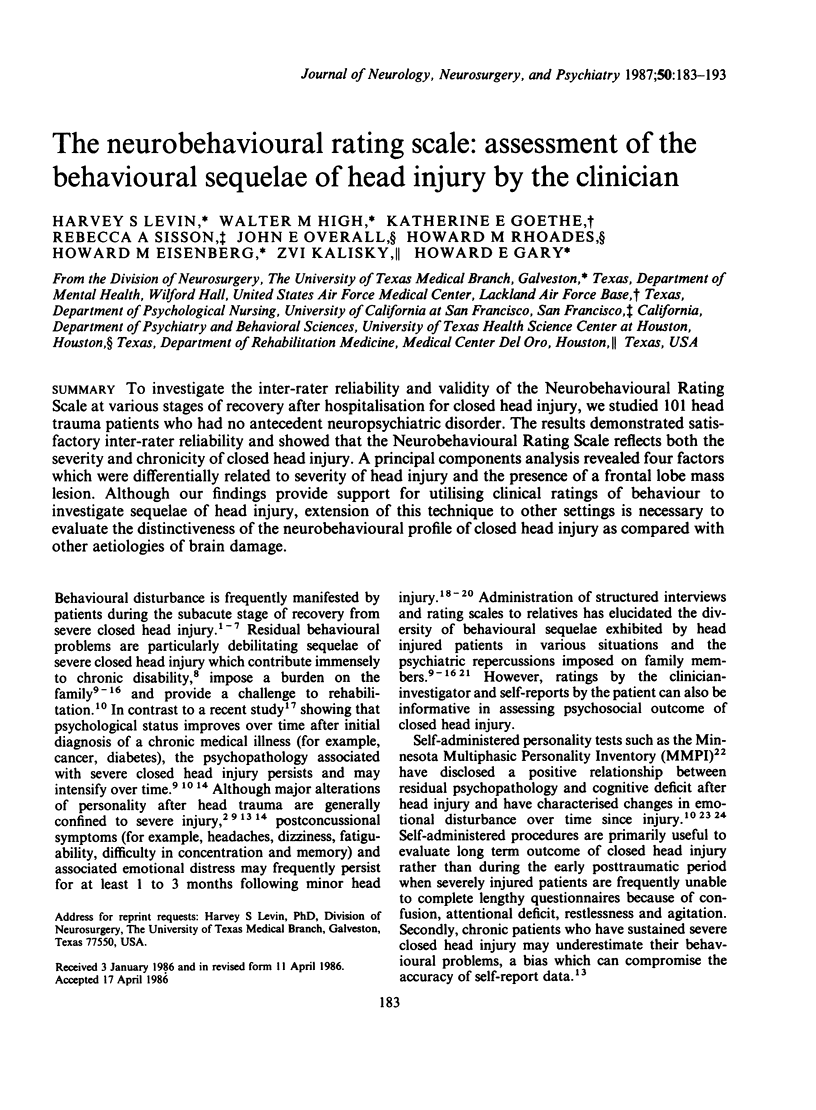
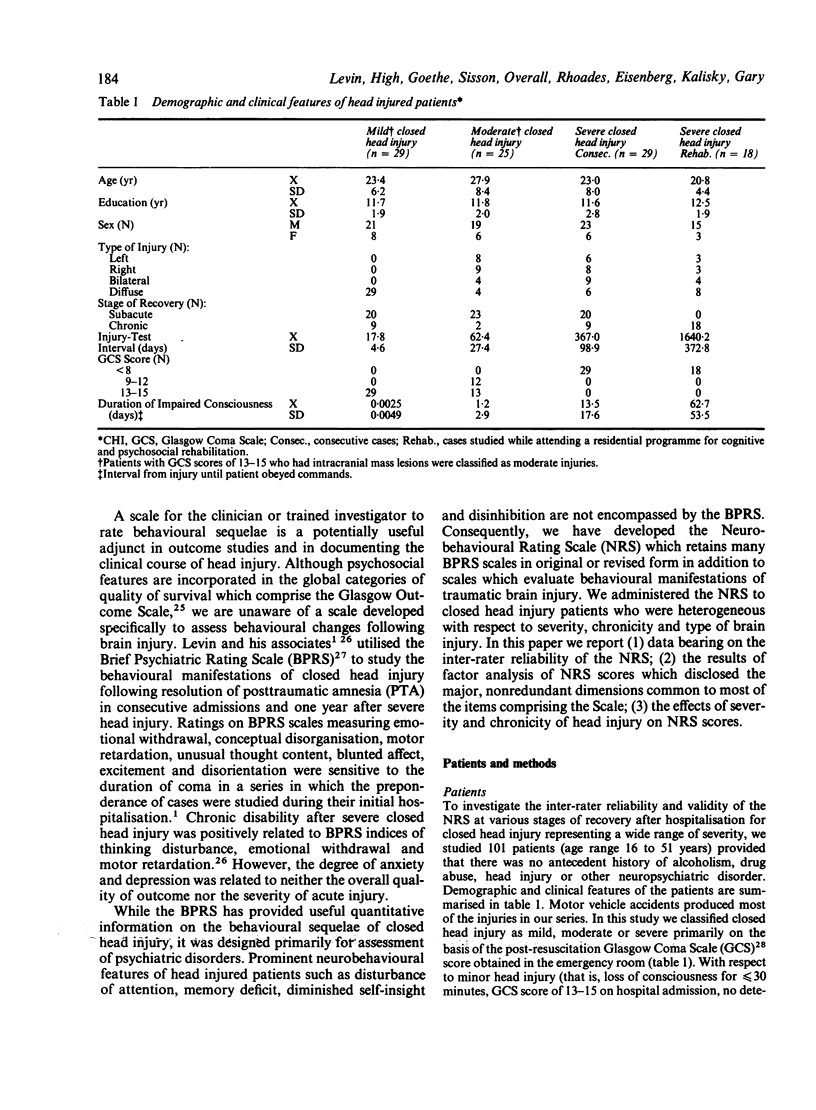
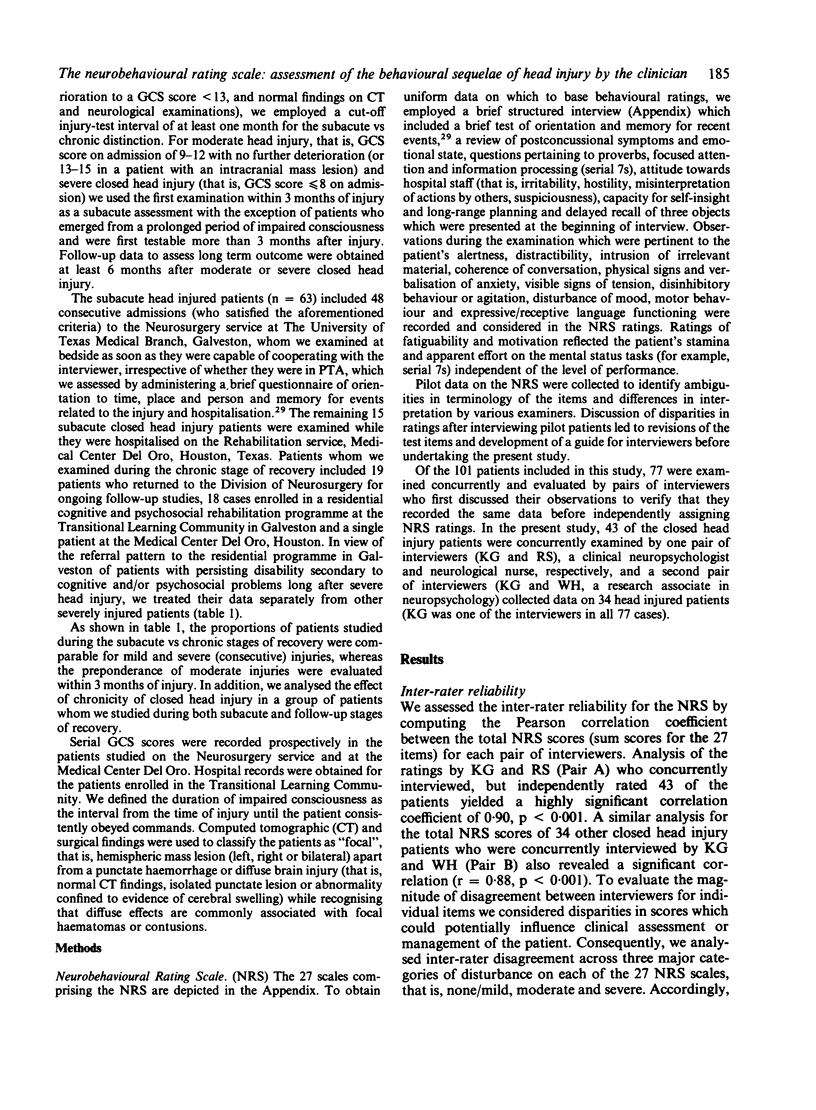
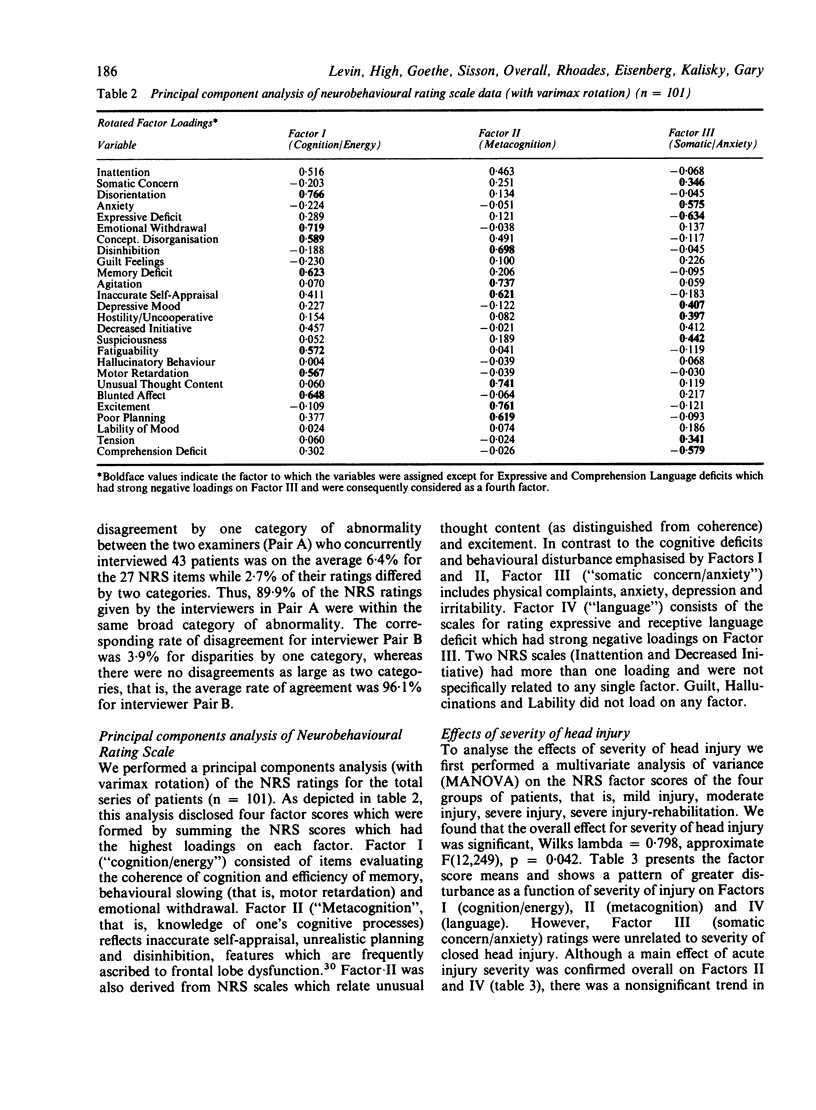
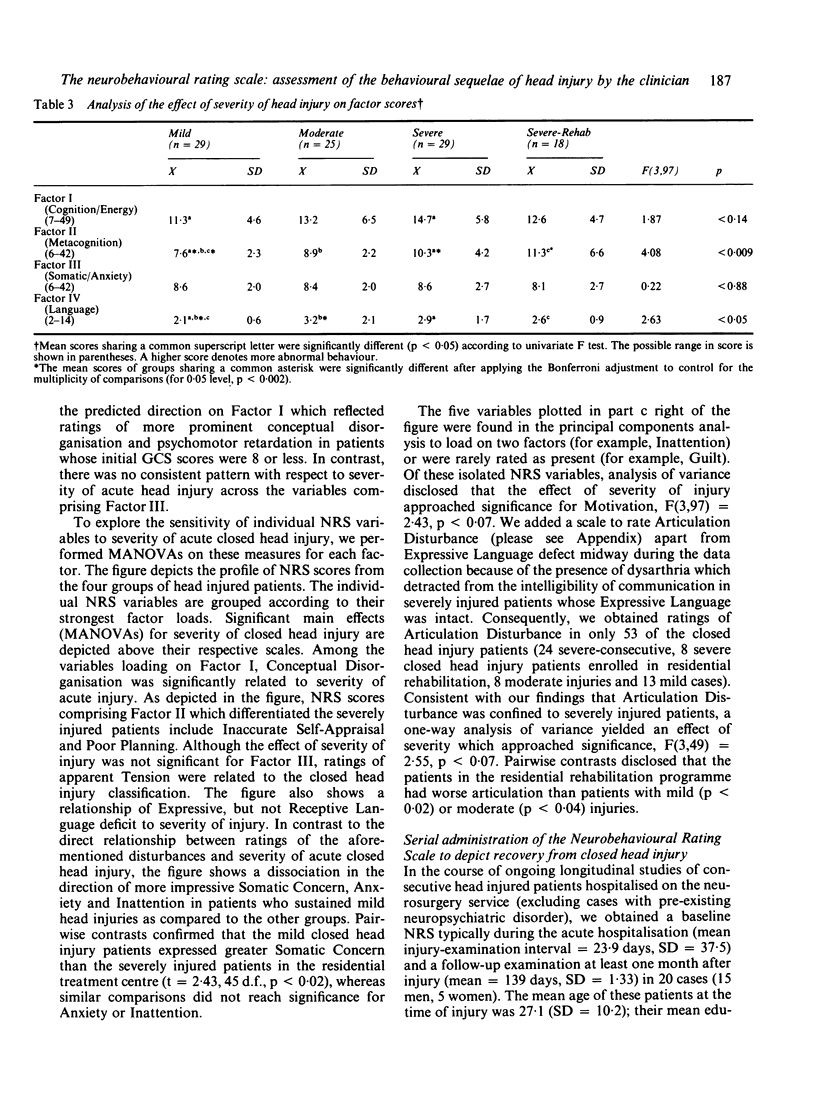
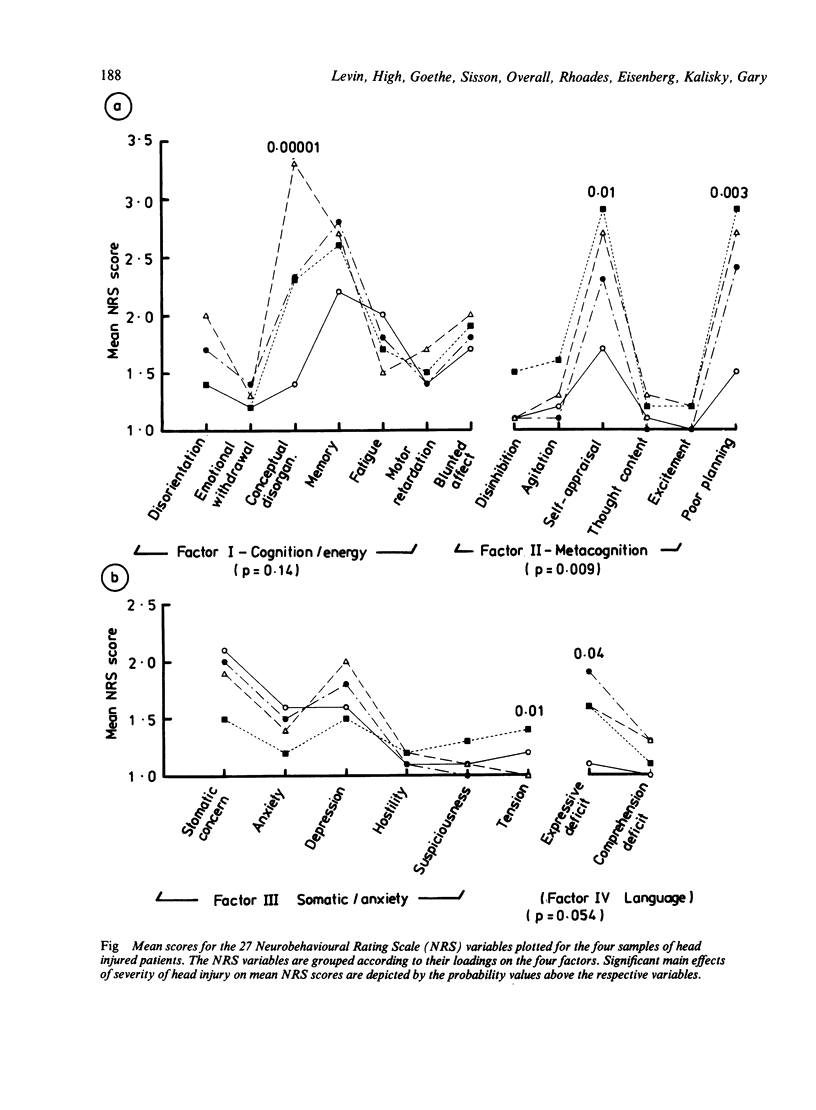
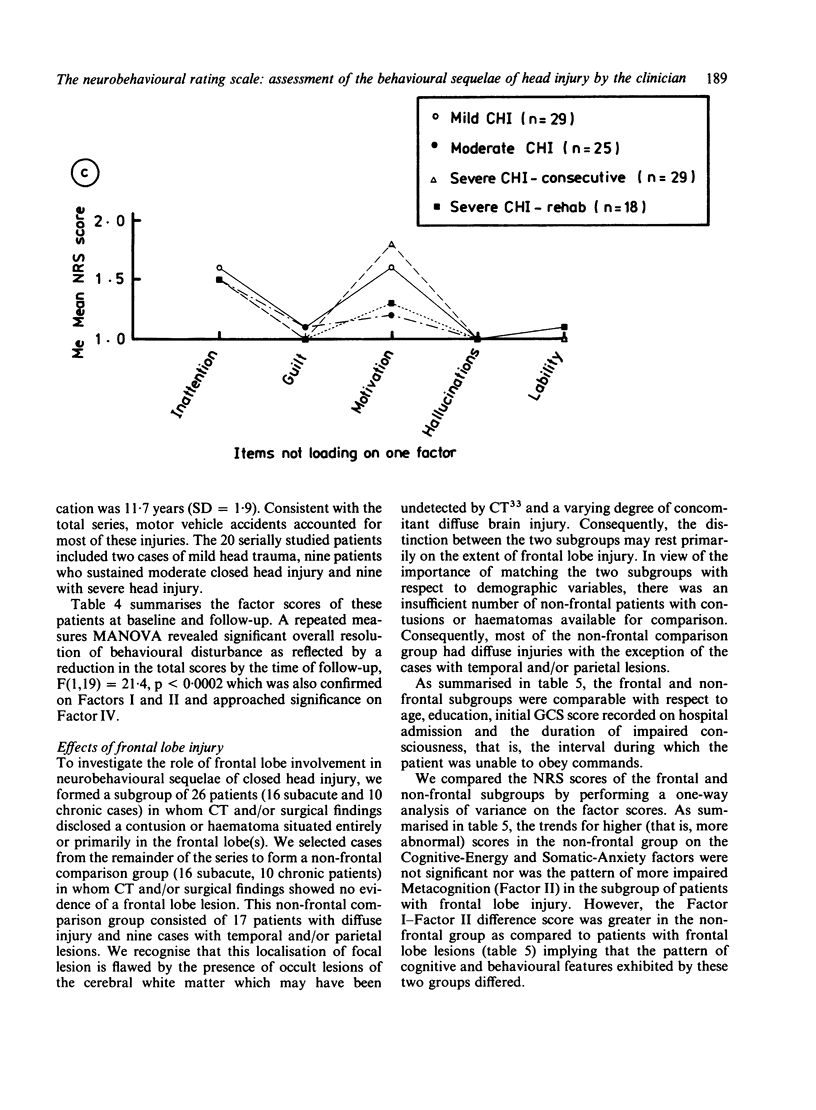
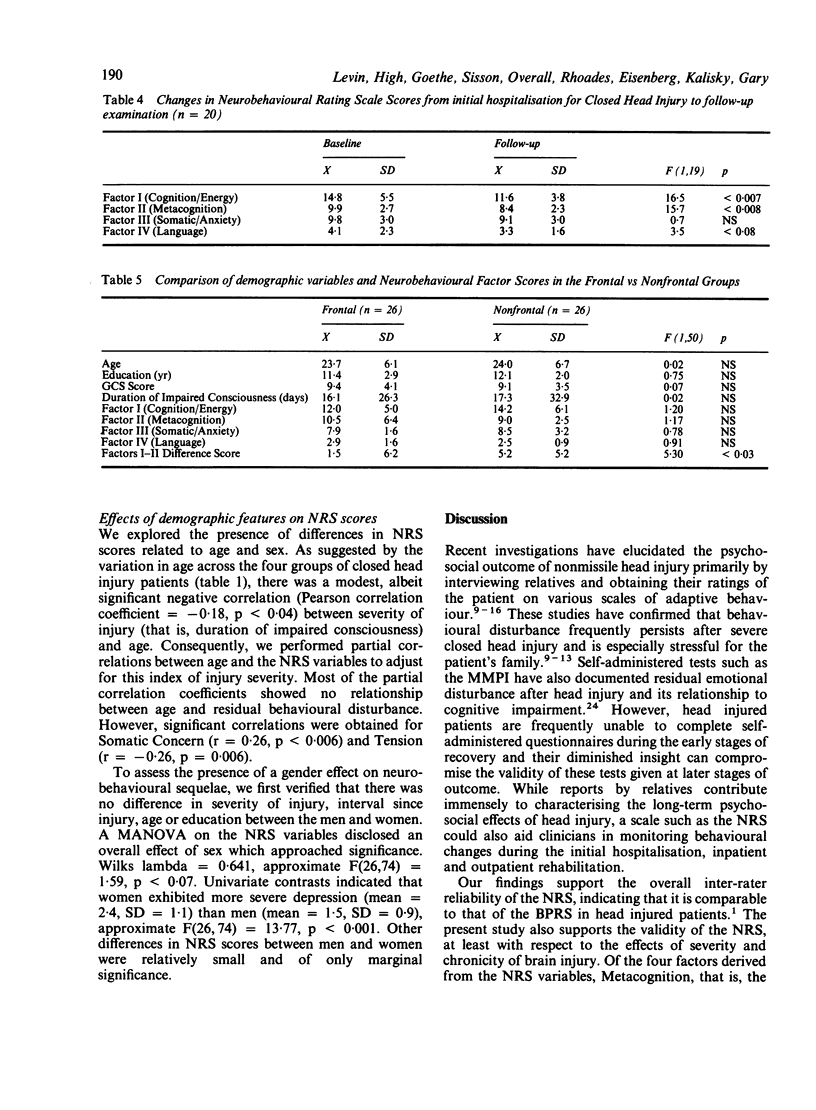
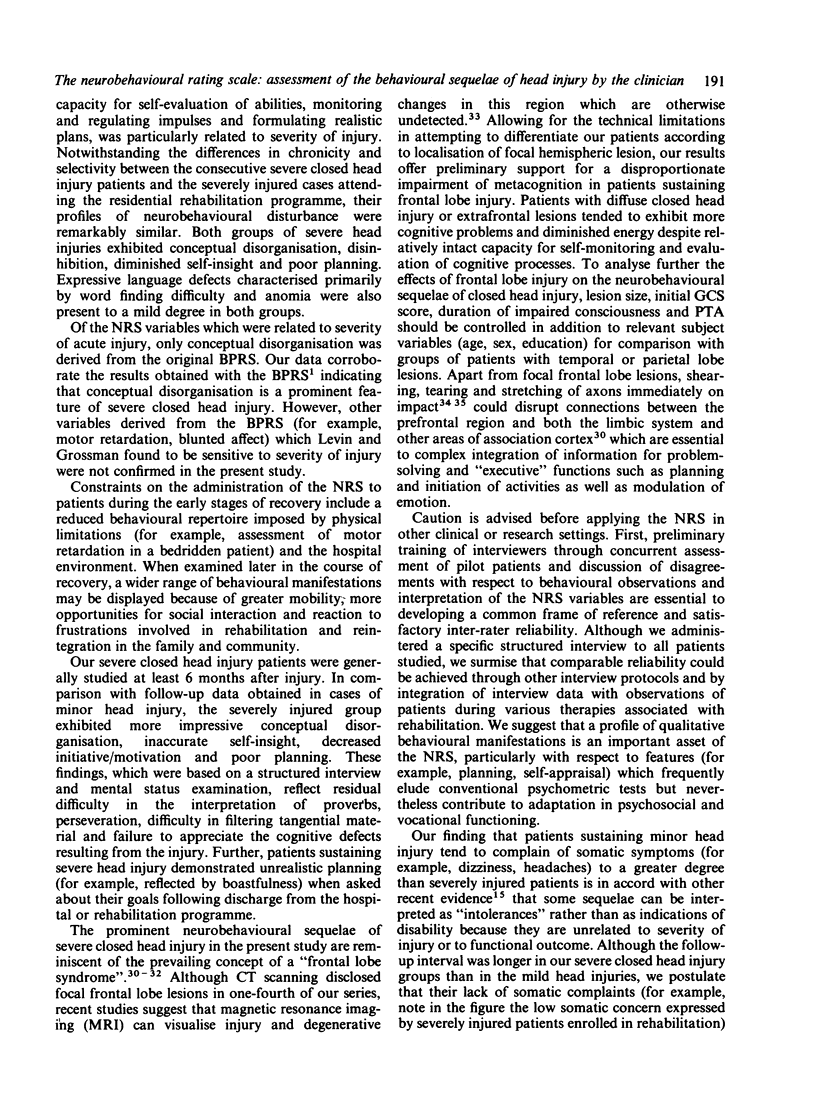
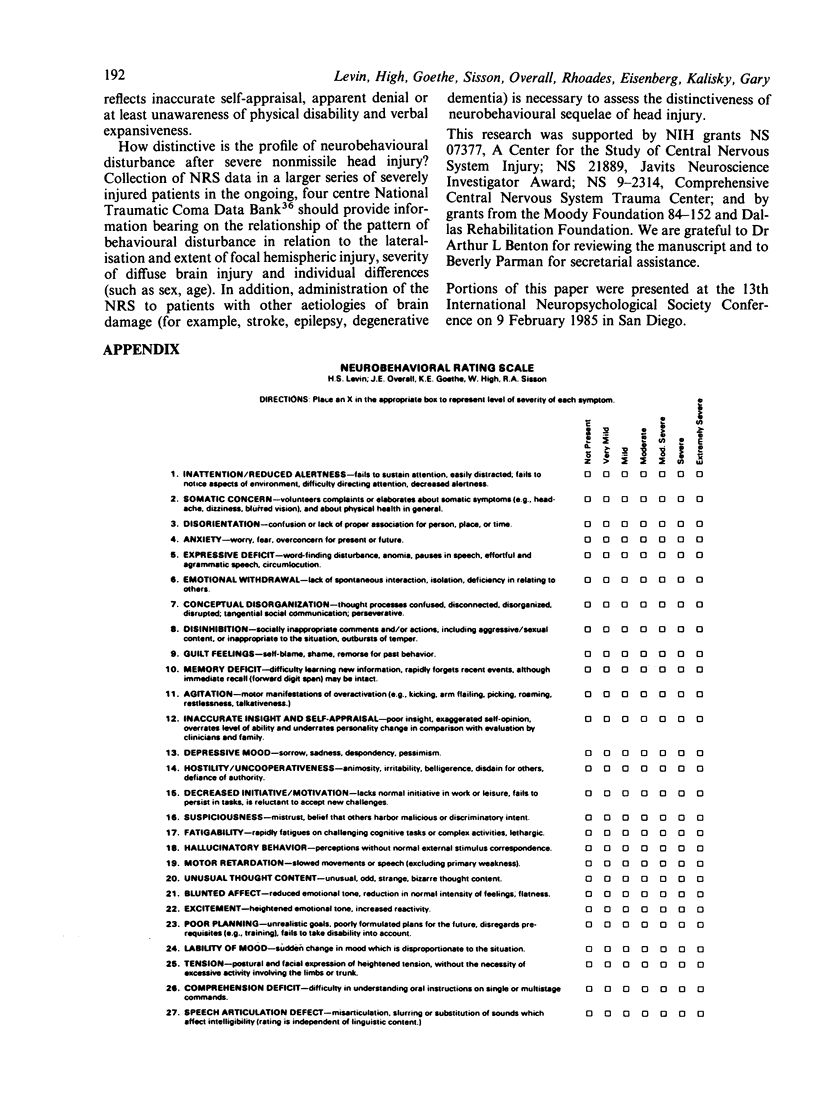
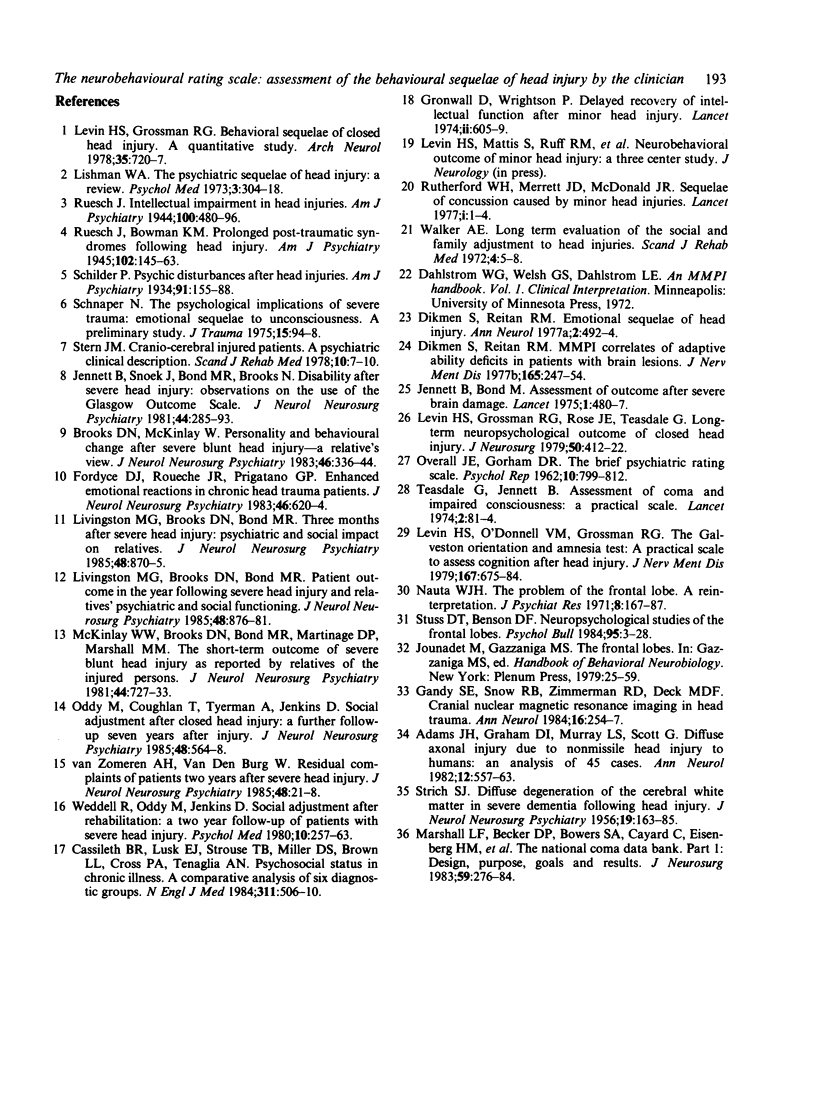
Selected References
These references are in PubMed. This may not be the complete list of references from this article.
- Adams J. H., Graham D. I., Murray L. S., Scott G. Diffuse axonal injury due to nonmissile head injury in humans: an analysis of 45 cases. Ann Neurol. 1982 Dec;12(6):557–563. doi: 10.1002/ana.410120610. [DOI] [PubMed] [Google Scholar]
- Brooks D. N., McKinlay W. Personality and behavioural change after severe blunt head injury--a relative's view. J Neurol Neurosurg Psychiatry. 1983 Apr;46(4):336–344. doi: 10.1136/jnnp.46.4.336. [DOI] [PMC free article] [PubMed] [Google Scholar]
- Cassileth B. R., Lusk E. J., Strouse T. B., Miller D. S., Brown L. L., Cross P. A., Tenaglia A. N. Psychosocial status in chronic illness. A comparative analysis of six diagnostic groups. N Engl J Med. 1984 Aug 23;311(8):506–511. doi: 10.1056/NEJM198408233110805. [DOI] [PubMed] [Google Scholar]
- Dikmen S., Reitan R. M. Emotional sequelae of head injury. Ann Neurol. 1977 Dec;2(6):492–494. doi: 10.1002/ana.410020608. [DOI] [PubMed] [Google Scholar]
- Dikmen S., Reitan R. M. MMPI correlates of adaptive ability deficits in patients with brain lesions. J Nerv Ment Dis. 1977 Oct;165(4):247–254. doi: 10.1097/00005053-197710000-00004. [DOI] [PubMed] [Google Scholar]
- Fordyce D. J., Roueche J. R., Prigatano G. P. Enhanced emotional reactions in chronic head trauma patients. J Neurol Neurosurg Psychiatry. 1983 Jul;46(7):620–624. doi: 10.1136/jnnp.46.7.620. [DOI] [PMC free article] [PubMed] [Google Scholar]
- Gandy S. E., Snow R. B., Zimmerman R. D., Deck M. D. Cranial nuclear magnetic resonance imaging in head trauma. Ann Neurol. 1984 Aug;16(2):254–257. doi: 10.1002/ana.410160217. [DOI] [PubMed] [Google Scholar]
- Gronwall D., Wrightson P. Delayed recovery of intellectual function after minor head injury. Lancet. 1974 Sep 14;2(7881):605–609. doi: 10.1016/s0140-6736(74)91939-4. [DOI] [PubMed] [Google Scholar]
- Jennett B., Bond M. Assessment of outcome after severe brain damage. Lancet. 1975 Mar 1;1(7905):480–484. doi: 10.1016/s0140-6736(75)92830-5. [DOI] [PubMed] [Google Scholar]
- Levin H. S., Grossman R. G. Behavioral sequelae of closed head injury. A quantitative study. Arch Neurol. 1978 Nov;35(11):720–727. doi: 10.1001/archneur.1978.00500350024005. [DOI] [PubMed] [Google Scholar]
- Levin H. S., Grossman R. G., Rose J. E., Teasdale G. Long-term neuropsychological outcome of closed head injury. J Neurosurg. 1979 Apr;50(4):412–422. doi: 10.3171/jns.1979.50.4.0412. [DOI] [PubMed] [Google Scholar]
- Levin H. S., O'Donnell V. M., Grossman R. G. The Galveston Orientation and Amnesia Test. A practical scale to assess cognition after head injury. J Nerv Ment Dis. 1979 Nov;167(11):675–684. doi: 10.1097/00005053-197911000-00004. [DOI] [PubMed] [Google Scholar]
- Lishman W. A. The psychiatric sequelae of head injury: a review. Psychol Med. 1973 Aug;3(3):304–318. doi: 10.1017/s003329170004959x. [DOI] [PubMed] [Google Scholar]
- Livingston M. G., Brooks D. N., Bond M. R. Patient outcome in the year following severe head injury and relatives' psychiatric and social functioning. J Neurol Neurosurg Psychiatry. 1985 Sep;48(9):876–881. doi: 10.1136/jnnp.48.9.876. [DOI] [PMC free article] [PubMed] [Google Scholar]
- Livingston M. G., Brooks D. N., Bond M. R. Three months after severe head injury: psychiatric and social impact on relatives. J Neurol Neurosurg Psychiatry. 1985 Sep;48(9):870–875. doi: 10.1136/jnnp.48.9.870. [DOI] [PMC free article] [PubMed] [Google Scholar]
- Marshall L. F., Becker D. P., Bowers S. A., Cayard C., Eisenberg H., Gross C. R., Grossman R. G., Jane J. A., Kunitz S. C., Rimel R. The National Traumatic Coma Data Bank. Part 1: Design, purpose, goals, and results. J Neurosurg. 1983 Aug;59(2):276–284. doi: 10.3171/jns.1983.59.2.0276. [DOI] [PubMed] [Google Scholar]
- Nauta W. J. The problem of the frontal lobe: a reinterpretation. J Psychiatr Res. 1971 Aug;8(3):167–187. doi: 10.1016/0022-3956(71)90017-3. [DOI] [PubMed] [Google Scholar]
- Oddy M., Coughlan T., Tyerman A., Jenkins D. Social adjustment after closed head injury: a further follow-up seven years after injury. J Neurol Neurosurg Psychiatry. 1985 Jun;48(6):564–568. doi: 10.1136/jnnp.48.6.564. [DOI] [PMC free article] [PubMed] [Google Scholar]
- Rutherford W. H. Sequelae of concussion caused by minor head injuries. Lancet. 1977 Jan 1;1(8001):1–4. doi: 10.1016/s0140-6736(77)91649-x. [DOI] [PubMed] [Google Scholar]
- STRICH S. J. Diffuse degeneration of the cerebral white matter in severe dementia following head injury. J Neurol Neurosurg Psychiatry. 1956 Aug;19(3):163–185. doi: 10.1136/jnnp.19.3.163. [DOI] [PMC free article] [PubMed] [Google Scholar]
- Schnaper N. The psychological implications of severe trauma: emotional sequelae to unconsciousness; A preliminary study. J Trauma. 1975 Feb;15(2):94–98. doi: 10.1097/00005373-197502000-00002. [DOI] [PubMed] [Google Scholar]
- Stuss D. T., Benson D. F. Neuropsychological studies of the frontal lobes. Psychol Bull. 1984 Jan;95(1):3–28. [PubMed] [Google Scholar]
- Teasdale G., Jennett B. Assessment of coma and impaired consciousness. A practical scale. Lancet. 1974 Jul 13;2(7872):81–84. doi: 10.1016/s0140-6736(74)91639-0. [DOI] [PubMed] [Google Scholar]
- Walker A. E. Long term evaluation of the social and family adjustment to head injuries. Scand J Rehabil Med. 1972;4(1):5–8. [PubMed] [Google Scholar]
- Weddell R., Oddy M., Jenkins D. Social adjustment after rehabilitation: a two year follow-up of patients with severe head injury. Psychol Med. 1980 May;10(2):257–263. doi: 10.1017/s0033291700044019. [DOI] [PubMed] [Google Scholar]
- van Zomeren A. H., van den Burg W. Residual complaints of patients two years after severe head injury. J Neurol Neurosurg Psychiatry. 1985 Jan;48(1):21–28. doi: 10.1136/jnnp.48.1.21. [DOI] [PMC free article] [PubMed] [Google Scholar]


